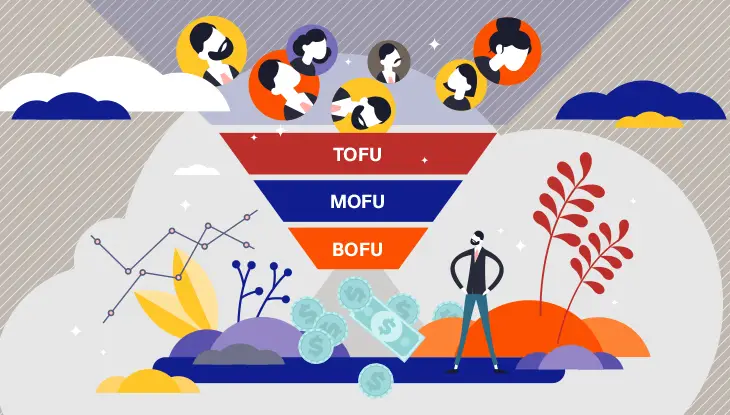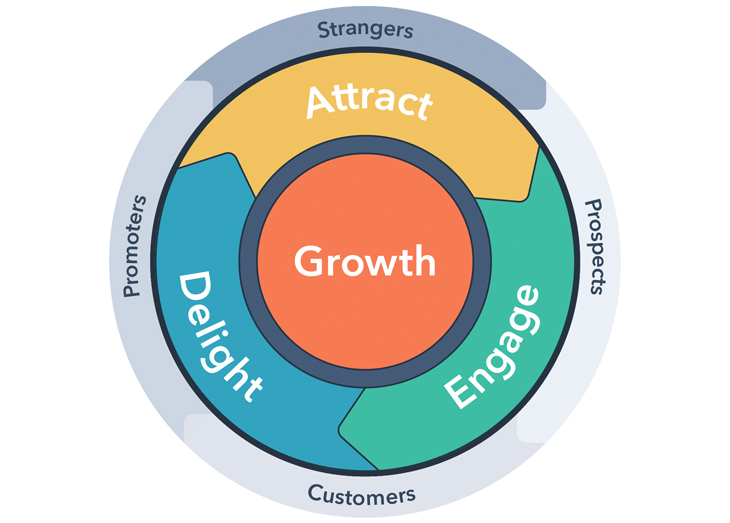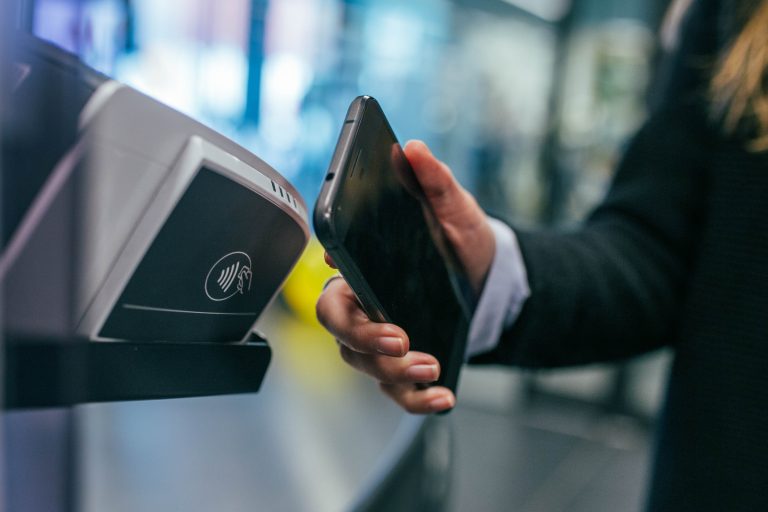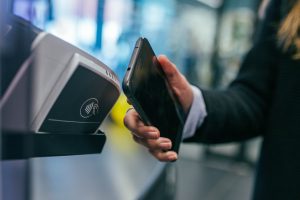It’s time to update our marketing vocabulary. Stash that crusty old funnel verbiage away at the back of a cabinet and mount a flywheel to the middle of your workbench.
There’s been a notable shift in how we think about lead generation. For sales and marketing, the funnel has long been the cornerstone model. You capture a lot of customer prospects at the top of the funnel and then channel them down through the process from consideration to sale.
As a model, it’s not a bad way to think about the customer journey. But it focuses too much on closing a sale as if that’s the total goal, full stop.
A marketing flywheel, on the other hand, is a circular model in which customers help create momentum and feed growth. When we think of marketing as a flywheel, we shift from an emphasis on customer acquisition to customer satisfaction.
3 Main Inbound Marketing Funnel Stages: TOFU, MOFU, BOFU

Meat eaters, I promise you, it’s safe to keep reading. If you are not a fan of tofu, those pale white bricks of coagulated bean curd, you’re in luck. This isn’t that.
When we picture a funnel, we see three basic stages: TOFU (top of the funnel), MOFU (middle of the funnel) and BOFU (bottom). The inbound marketing funnel mostly falls in line with the traditional sales funnel, with one key difference: The inbound funnel tells us what our customers want to hear from us in each stage.
1. TOFU is the awareness stage
This is your widest audience. At this stage, customers are learning. They may not even be aware they have a problem, so avoid pushing them away with a hard sell. You may be reaching them with social media, PPC ads, content marketing, or other channels.
2. MOFU is the consideration stage
At this point, buyers are evaluating your company to decide if your solution will help them in a meaningful way. MOFU can be fueled by email and content marketing to educate them about your solution and help them make up their mind.
3. BOFU is the decision stage
Your goal is to reinforce the value you provide and make it easy for the customer to buy. Inbound marketing tools here include testimonials and case studies, customer reviews and other user-generated content—the kind of gold-plated goodies you get from happy customers.
3 Flywheel Elements To Fuel Continuous Lead Gen

Th e marketing flywheel keeps us mindful of how satisfied customers provide leverage to fuel our growth. In this model, three marketing phases (attract, engage, delight) spin around the customer at the axis. Customers are the hub of our marketing, not inputs we dump into a funnel.
- Attract
- Engage
- Delight
Attract is the lead generation phase, similar to the TOFU awareness stage. Our goal is to make the customer aware of our business and draw them in, and the same inbound marketing tactics would apply.
Engage reflects the consideration and decision stages (MOFU & BOFU). Here you’re giving prospects content that builds their interest and confidence in your capabilities. You demonstrate there’s real value to be gained from engaging with your brand and moving forward with your solution.
Remember, though, our end goal is not just to make a sale — it’s to satisfy the customer. We never want the customer to feel like they “got sold.” We’re providing useful information and crafting content with a sincere ethic of care for our customers.
Delight is the critical phase that sets the flywheel apart from the funnel. This is where we deliver on the promises we made and wow our customer with superior service.
Acing the delight phase creates the ultimate powerhouse marketing tool: a happy customer. Once we have them, we can focus on nurturing that relationship with the goal of generating new leads, e.g., either another sale from our happy customer or a referral to others.
Delighting the customer involves active participation from everyone in the organization—from marketing and sales which must not promise more than the company can deliver, to your product teams, to customer service.
Even if our sale is short-term in nature, inbound marketers can continue to show up for past customers by providing ongoing value in the form of customer education, “member-only” events, or exclusive early-access to new products or promotions which can lead to more sales or referrals.

The Marketing Flywheel = Best Inbound Funnel for ROI
Nurturing your existing customers has far better ROI than building new ones.
Industry studies suggest it’s anywhere from 5 to 25 times more expensive to acquire a customer than retain an existing one. And increasing customer retention by just 5% can increase profit by 25% to 95%, according to research from Bain & Company and Harvard Business School.
At the end of the day, the flywheel model keeps everyone in your organization centered on the same goal: keeping the flywheel spinning. A focus on creating and sustaining happy customers can give your marketing a powerful force of momentum.






